New Reports
Priority Areas for Development Cooperation in Agricultural Sector with Seven Asian countries

- Author: Heo Jang, Lee Daeseob, Kim Jongsun, Kim Yunjung, Choi Minjung, Cho Sunmee, Ahn Kyumi
- Publisher: Korea Rural Economic Institute(KREI)
- Publication Date: Dec.2017
The Purpose of this study was to select Korea’s priority partner countries in agricultural sector, to find priority areas for development cooperation for those countries, and to plan future Official Development Assistance (ODA) projects for the Ministry of Agriculture, Food and Rural Affairs of Korea.
This study was performed by reviewing the previous literature and related materials, utilizing manuscripts written by professionals, and conducting surveys and interviews with officials in charge of agricultural and rural development policy in partner countries.
The countries which meet the following criteria were selected as Korea’s priority partner countries; the countries in which agricultural sector was chosen as the key area of cooperation among Korea’s ODA priority partner countries in 2015: Korea’s priority countries for overseas agricultural development: countries that had signed bilateral memorandum of understanding with Korea in agricultural sector: and the countries in which the performances of the Korean Agricultural Policy Experiences for Food Security (KAPEX) program proved excellent. As a result, seven Asian Countries were selected, including Cambodia, Indonesia, Lao PDR, Myanmar, Mongolia, the Philippines, and Vietnam.
To suggest priority areas for cooperation with those seven Asian countries, this study reviewed social and economic situations and current status of the agricultural sector, national and agricultural development strategies, country partnership strategies of international organizations, and previous development cooperation projects supported by Korean government (MAFRA and its subsidiary organizations, and the KOICA). The review resulted in two to four priority areas of cooperation in agricultural and rural development sector for each country.
Full text will be updated in the KREI Website(www.krei.re.kr) soon.
Controlling Corruption in Development Aid: New Evidence from Contract-Level Data
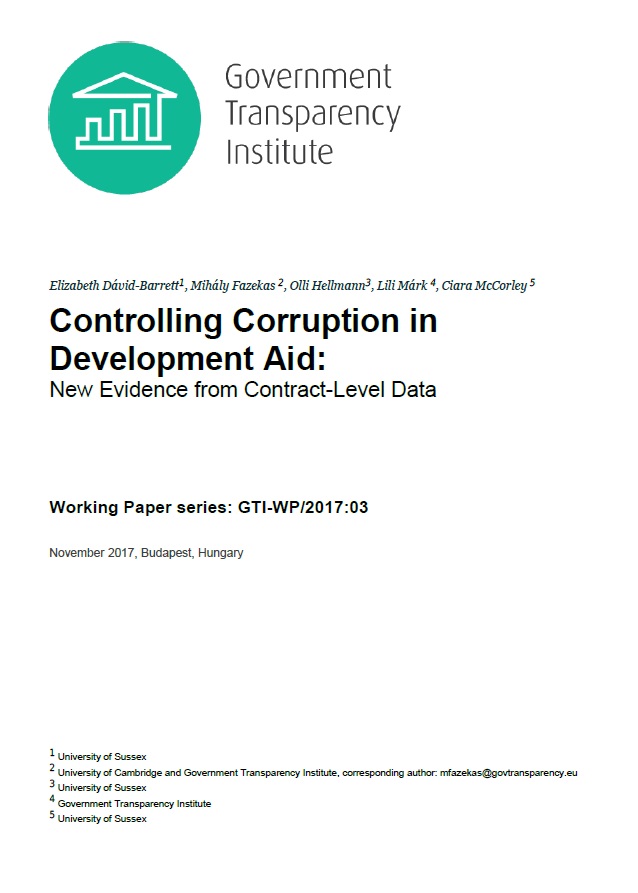
- Author: Elizabeth Dávid-Barrettt, Mihaly Fazekas, Olli Hellmann, Lili Márk, Ciara McCorley
- Publisher: Budapest: Government Transparency Institute
- Publication Date: Jan. 2018
Following scandals about corruption in foreign aid, and in a political climate that increasingly questions the legitimacy of development assistance, donors are under pressure to control how their funds are spent. At the same time, they also face pressure to trust recipient governments to disburse project funds themselves, so as to build capacity in developing countries. This paper assesses under which conditions donor regulations are successful in controlling corruption in aid spent by national governments through procurement tenders. By mining procurement contracts funded by the World Bank in 100 countries over the period 1998-2008 for corruption “red flags”, we create a dataset that provides an unprecedentedly accurate picture of corruption risks in the spending of aid across the developing world. Through propensity score matching and regression analysis, we find that the 2003 World Bank regulatory reform aiming to control corruption was effective in reducing corruption risks: lowering single bidding on competitive markets by 3.8-4.3 percentage points. This effect is greater in countries with low state capacity.
Full text will be updated in the KREI Website(www.krei.re.kr) soon.
Does rural development aid reduce international migration?
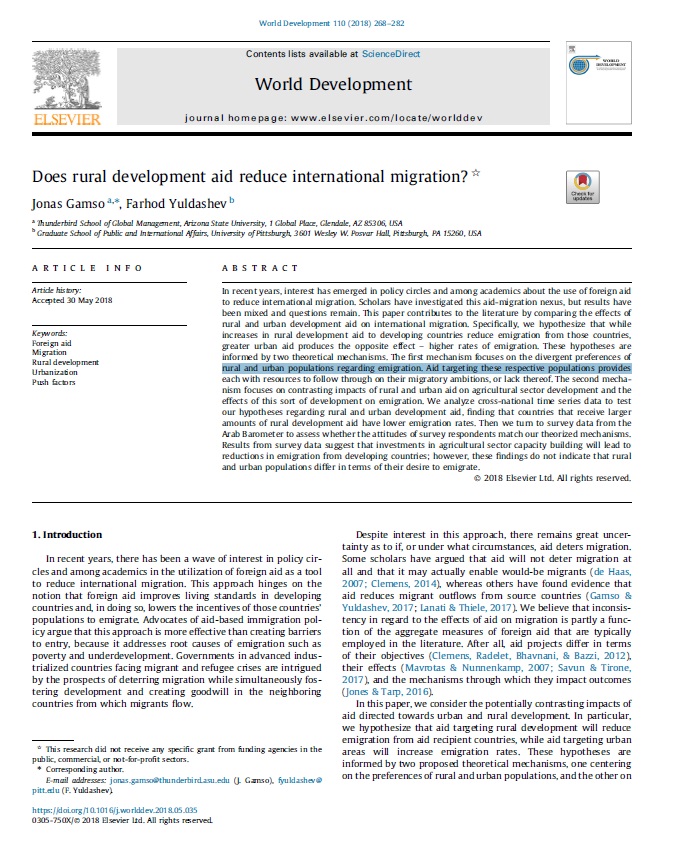
- Author: Jonas Gamso, Farhod Yuldashev
- Publisher: World Development
- Publication Date: October 2018(In Progress)
In recent years, interest has emerged in policy circles and among academics about the use of foreign aid to reduce international migration. Scholars have investigated this aid-migration nexus, but results have been mixed and questions remain. This paper contributes to the literature by comparing the effects of rural and urban development aid on international migration. Specifically, we hypothesize that while increases in rural development aid to developing countries reduce emigration from those countries, greater urban aid produces the opposite effect – higher rates of emigration. These hypotheses are informed by two theoretical mechanisms. The first mechanism focuses on the divergent preferences of rural and urban populations regarding emigration. Aid targeting these respective populations provides each with resources to follow through on their migratory ambitions, or lack thereof. The second mechanism focuses on contrasting impacts of rural and urban aid on agricultural sector development and the effects of this sort of development on emigration. We analyze cross-national time series data to test our hypotheses regarding rural and urban development aid, finding that countries that receive larger amounts of rural development aid have lower emigration rates. Then we turn to survey data from the Arab Barometer to assess whether the attitudes of survey respondents match our theorized mechanisms. Results from survey data suggest that investments in agricultural sector capacity building will lead to reductions in emigration from developing countries; however, these findings do not indicate that rural and urban populations differ in terms of their desire to emigrate.
Full text will be updated in the KREI Website(www.krei.re.kr) soon.
The effect of foreign aid on foreign direct investment inflows: Evidence from Africa
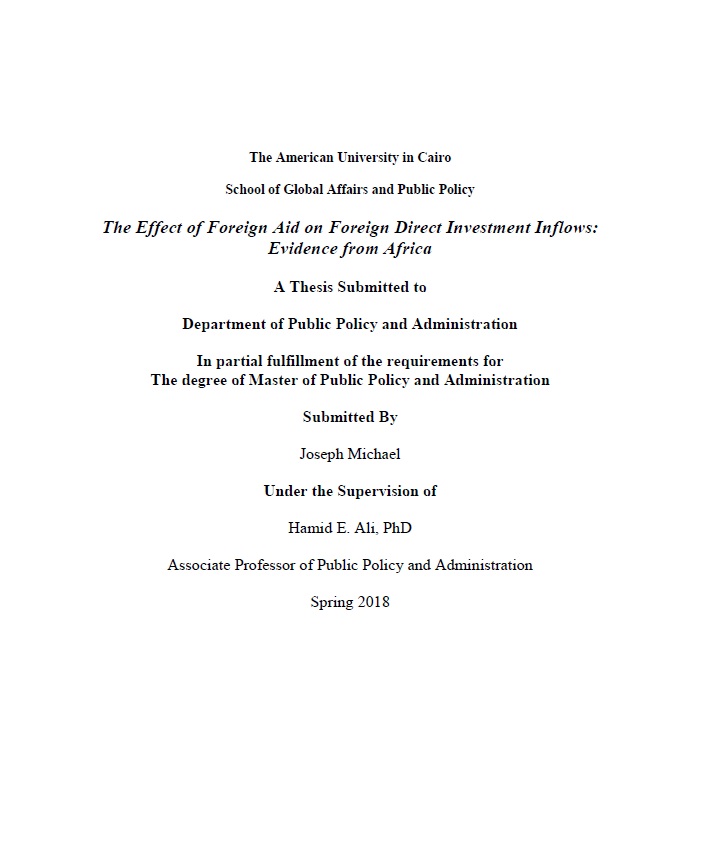
- Author: Michael, Joseph
- Publisher: American University in Cairo. Dept. of Public Policy and Administration
- Publication Date: Feb. 2018
This thesis examines the impact of foreign aid on foreign direct investment (FDI) in Africa. Since there is no consensus in the literature regarding the effects of foreign aid on FDI in developing countries, the thesis examines the empirical relationship between foreign aid and FDI in Africa covering 41 African countries between 1995 and 2015. The analysis controls for market size, level of development, economic trade openness, political stability, and natural resources dependency. The model is estimated using a dynamic panel of System Generalized Method of Moments (GMM) estimation to address endogeneity problem. The model is applied to panel data compiled from publicly available databases. The results of this analysis show support of initial hypotheses that foreign aid can have positive impact on FDI. In addition, while recent studies tend to consider disaggregating aid sectors for infrastructure, and education among others, this thesis argues that aid function channels more impact on a country’s economy rather than being confined to targeted sectors. The results also indicate a significant positive impact associated with development aid channeled through multilaterals on FDI inflows. Consequently, governments’ policies to increase FDI must account for efficient utilization of foreign aid where as policies need to be developed not in isolation from each other. In addition, development partners should channel more funds through multilateral institutions to maximize the effectiveness of foreign aid.
Full Text of the Report
Empowering the poor: A field study of the social psychological consequences of receiving autonomy or dependency aid in Panama
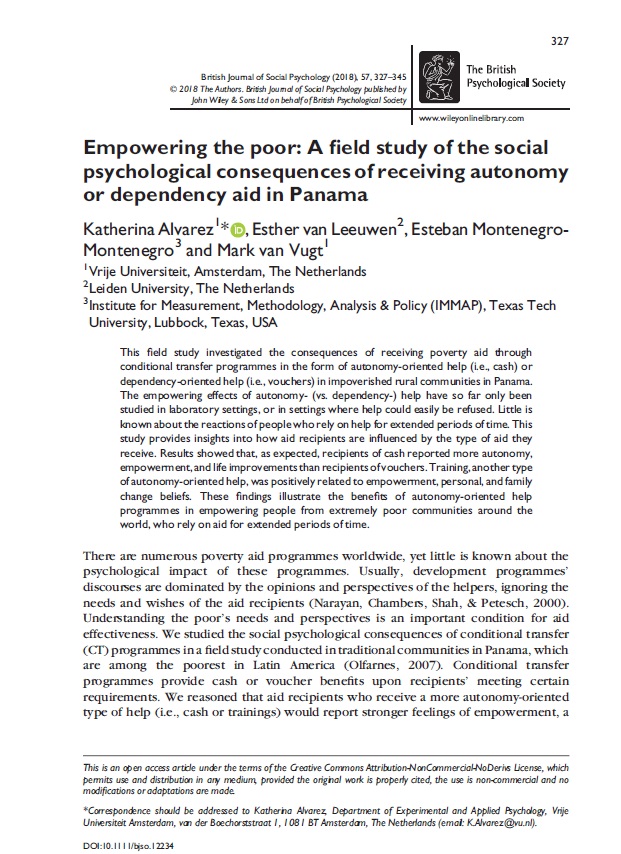
- Author: Katherina Alvarez, Esther van Leeuwen, Esteban Montenegro-Montenegro, Mark van Vugt
- Publisher:The British Psychological Society
- Publication Date: 2018
This field study investigated the consequences of receiving poverty aid throughconditional transfer programmes in the form of autonomy-oriented help (i.e., cash) ordependency-oriented help (i.e., vouchers) in impoverished rural communities in Panama.The empowering effects of autonomy- (vs. dependency-) help have so far only beenstudied in laboratory settings, or in settings where help could easily be refused. Little isknown about the reactions of people who rely on help for extended periods of time. Thisstudy provides insights into how aid recipients are influenced by the type of aid theyreceive. Results showed that, as expected, recipients of cash reported more autonomy,empowerment, and life improvements than recipients of vouchers. Training, another typeof autonomy-oriented help, was positively related to empowerment, personal, and familychange beliefs. These findings illustrate the benefits of autonomy-oriented helpprogrammes in empowering people from extremely poor communities around theworld, who rely on aid for extended periods of time.
Full Text of the Report
Vulnerability, good governance, or donor interests? The allocation of aid for climate change adaptation
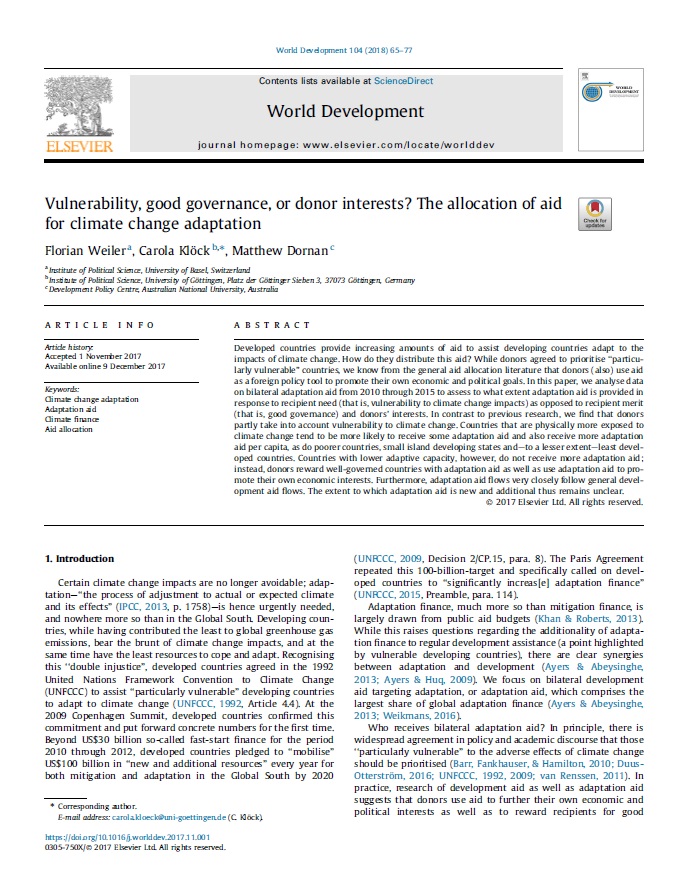
- Author: Florian Weiler, Carola Klöck, Matthew Dorman
- Publisher: World Development
- Publication Date: April. 2018
Developed countries provide increasing amounts of aid to assist developing countries adapt to the impacts of climate change. How do they distribute this aid? While donors agreed to prioritise “particularly vulnerable” countries, we know from the general aid allocation literature that donors (also) use aid as a foreign policy tool to promote their own economic and political goals. In this paper, we analyse data on bilateral adaptation aid from 2010 through 2015 to assess to what extent adaptation aid is provided in response to recipient need (that is, vulnerability to climate change impacts) as opposed to recipient merit (that is, good governance) and donors’ interests. In contrast to previous research, we find that donors partly take into account vulnerability to climate change. Countries that are physically more exposed to climate change tend to be more likely to receive some adaptation aid and also receive more adaptation aid per capita, as do poorer countries, small island developing states and—to a lesser extent—least developed countries. Countries with lower adaptive capacity, however, do not receive more adaptation aid; instead, donors reward well-governed countries with adaptation aid as well as use adaptation aid to promote their own economic interests. Furthermore, adaptation aid flows very closely follow general development aid flows. The extent to which adaptation aid is new and additional thus remains unclear.
Full Text of the Report
CO2 mitigation in developing countries: the role of foreign aid

- Author: Mohamed BOLY
- Publisher: Centre d’Etudes et de Recherches sur le Développement International
- Publication Date: Jan. 2018
This paper empirically investigates the link between foreign aid and pollution, specifically CO2 emissions in developing countries. We use a more complete and recent dataset to re-assess the environmental impact of foreign aid. Focusing on 112 aid recipient countries over the period 1980 - 2013, we find that the effect of aid depends on the donor, with multilateral aid more likely to reduce pollution than bilateral aid for which we find no effect. However, when we more precisely look at the composition of bilateral aid, we find it has an effect when specifically targeted toward environment. This effect is non-linear, since we observe a pollution-reducing effect only for important amounts of bilateral environmental aid.
Full Text of the Report
The Role of Private Standards for manufactured Food Exports from Developing Countries

- Author: Malte Ehrich, Axel Mangelsdorf
- Publisher: World Development
- Publication Date: Jan. 2018
The relevance of non-tariff barriers for global trade flows has increased in recent decades. However, the effect of food standards—as a particular important non-tariff measure—on agricultural trade flows remains unclear. We contribute to the debate with a unique dataset that contains the number of food processing firms of 87 countries from 2008 to 2013 that are certified with the International Featured Standard (IFS). We estimate a gravity model using the one-year lag of IFS as well as IFS certification in neighboring countries as an instrument to address potential endogeneity. We find that IFS increases c.p. bilateral exports on average of seven agricultural product categories in both specifications. However, the effect remains robust only for high- and middle-income countries and disappears for low-income countries. Hence, while IFS increases exports on average, low-income countries do not benefit in terms of higher export volumes. Moreover, once we separate the dataset by sector, the trade-enhancing effect remains for bakery, dairy, and beverage sectors only. Overall, we argue that food standards are not a suitable development tool to integrate low-income countries into high-value chains per se.
Full Text of the Report
Apples and Dragon Fruits: The Determinants of Aid and Other Forms of State Financing from China to Africa

- Author: Axel Dreher, Andreas Fuchs, Brad Parks, Austin M Strange, Michael J Tierney
- Publisher: Oxford Academic
- Publication Date: Feb. 2018
Chinese “aid” is a lightning rod for criticism. Policy-makers, journalists, and public intellectuals claim that Beijing uses its largesse to cement alliances with political leaders, secure access to natural resources, and create exclusive commercial opportunities for Chinese firms—all at the expense of citizens living in developing countries. We argue that much of the controversy about Chinese “aid” stems from a failure to distinguish between China's Official Development Assistance (ODA) and more commercially oriented sources and types of state financing. Using a new database on China's official financing commitments to Africa from 2000 to 2013, we find that the allocation of Chinese ODA is driven primarily by foreign policy considerations, while economic interests better explain the distribution of less concessional flows. These results highlight the need for better measures of an increasingly diverse set of non-Western financial activities.
Full Text of the Report

